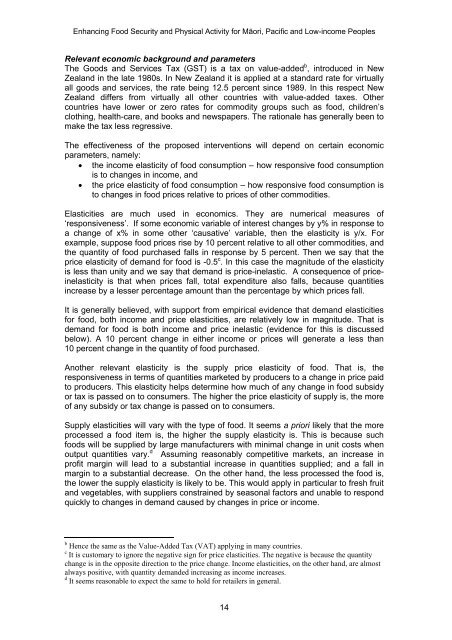enhancing food security and physical activity for maori, pacific and ...
enhancing food security and physical activity for maori, pacific and ...
enhancing food security and physical activity for maori, pacific and ...
- No tags were found...
You also want an ePaper? Increase the reach of your titles
YUMPU automatically turns print PDFs into web optimized ePapers that Google loves.
Enhancing Food Security <strong>and</strong> Physical Activity <strong>for</strong> Māori, Pacific <strong>and</strong> Low-income PeoplesRelevant economic background <strong>and</strong> parametersThe Goods <strong>and</strong> Services Tax (GST) is a tax on value-added b , introduced in NewZeal<strong>and</strong> in the late 1980s. In New Zeal<strong>and</strong> it is applied at a st<strong>and</strong>ard rate <strong>for</strong> virtuallyall goods <strong>and</strong> services, the rate being 12.5 percent since 1989. In this respect NewZeal<strong>and</strong> differs from virtually all other countries with value-added taxes. Othercountries have lower or zero rates <strong>for</strong> commodity groups such as <strong>food</strong>, children’sclothing, health-care, <strong>and</strong> books <strong>and</strong> newspapers. The rationale has generally been tomake the tax less regressive.The effectiveness of the proposed interventions will depend on certain economicparameters, namely:• the income elasticity of <strong>food</strong> consumption – how responsive <strong>food</strong> consumptionis to changes in income, <strong>and</strong>• the price elasticity of <strong>food</strong> consumption – how responsive <strong>food</strong> consumption isto changes in <strong>food</strong> prices relative to prices of other commodities.Elasticities are much used in economics. They are numerical measures of‘responsiveness’. If some economic variable of interest changes by y% in response toa change of x% in some other ‘causative’ variable, then the elasticity is y/x. Forexample, suppose <strong>food</strong> prices rise by 10 percent relative to all other commodities, <strong>and</strong>the quantity of <strong>food</strong> purchased falls in response by 5 percent. Then we say that theprice elasticity of dem<strong>and</strong> <strong>for</strong> <strong>food</strong> is -0.5 c . In this case the magnitude of the elasticityis less than unity <strong>and</strong> we say that dem<strong>and</strong> is price-inelastic. A consequence of priceinelasticityis that when prices fall, total expenditure also falls, because quantitiesincrease by a lesser percentage amount than the percentage by which prices fall.It is generally believed, with support from empirical evidence that dem<strong>and</strong> elasticities<strong>for</strong> <strong>food</strong>, both income <strong>and</strong> price elasticities, are relatively low in magnitude. That isdem<strong>and</strong> <strong>for</strong> <strong>food</strong> is both income <strong>and</strong> price inelastic (evidence <strong>for</strong> this is discussedbelow). A 10 percent change in either income or prices will generate a less than10 percent change in the quantity of <strong>food</strong> purchased.Another relevant elasticity is the supply price elasticity of <strong>food</strong>. That is, theresponsiveness in terms of quantities marketed by producers to a change in price paidto producers. This elasticity helps determine how much of any change in <strong>food</strong> subsidyor tax is passed on to consumers. The higher the price elasticity of supply is, the moreof any subsidy or tax change is passed on to consumers.Supply elasticities will vary with the type of <strong>food</strong>. It seems a priori likely that the moreprocessed a <strong>food</strong> item is, the higher the supply elasticity is. This is because such<strong>food</strong>s will be supplied by large manufacturers with minimal change in unit costs whenoutput quantities vary. d Assuming reasonably competitive markets, an increase inprofit margin will lead to a substantial increase in quantities supplied; <strong>and</strong> a fall inmargin to a substantial decrease. On the other h<strong>and</strong>, the less processed the <strong>food</strong> is,the lower the supply elasticity is likely to be. This would apply in particular to fresh fruit<strong>and</strong> vegetables, with suppliers constrained by seasonal factors <strong>and</strong> unable to respondquickly to changes in dem<strong>and</strong> caused by changes in price or income.b Hence the same as the Value-Added Tax (VAT) applying in many countries.c It is customary to ignore the negative sign <strong>for</strong> price elasticities. The negative is because the quantitychange is in the opposite direction to the price change. Income elasticities, on the other h<strong>and</strong>, are almostalways positive, with quantity dem<strong>and</strong>ed increasing as income increases.d It seems reasonable to expect the same to hold <strong>for</strong> retailers in general.14
















